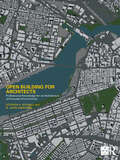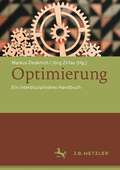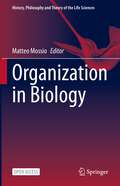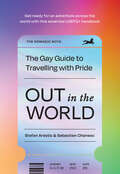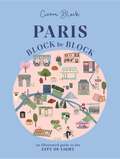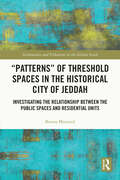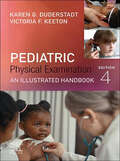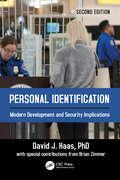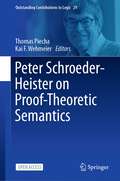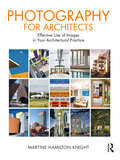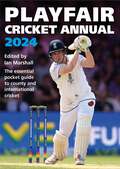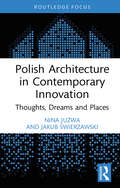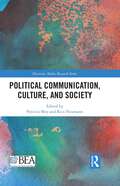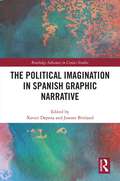- Table View
- List View
Open Building for Architects: Professional Knowledge for an Architecture of Everyday Environment (Open Building)
by Stephen H. Kendall N. John HabrakenOpen Building is an internationally recognized approach to the design of buildings and building complexes with roots in the way the ordinary built environment grows and regenerates. The Open Building approach recognizes that both stability and change are realities to be managed in the contemporary built environment. Buildings – and the neighborhoods they occupy – are not static during the most stable times or during times of rapid social and technical change. They are living organisms that need constant adjustments to remain attractive, safe and valuable.Using case studies of built projects from around the world, this book explains the Open Building approach and discusses important characteristics of everyday built environment that the Open Building approach designs for. It also presents a key method that can be used to put the approach into use. It addresses questions such as: How can we design large projects for inevitable change? How can we balance the demands of large projects for efficient implementation with the need for ‘fine-grained’ decision-making control? How can we separate design tasks, one task being the design of what should last a century, the other task being the design of more mutable units of occupancy? How can we identify and share architectural themes and, at the same time, make variations on them? How can we use the Open Building approach to steward the earth’s scarce resources and contribute to a circular economy that benefits all people? This book is an essential resource for practitioners, investors and developers, regulators, builders, product manufacturers and educators interested in why the Open Building approach matters and how to practice Open Building.
Optimierung: Ein interdisziplinäres Handbuch
by Markus Dederich Jörg ZirfasDieses interdisziplinäre Handbuch rekonstruiert Optimierung als ein Phänomen, das konstitutiv in aktuelle Entwicklungen der Gegenwart eingeschrieben ist. Denn es erscheint kaum mehr möglich, nicht optimieren zu wollen oder zu können. Das gilt für die Arbeit an sich selbst, die Verbesserung des Anderen und die Perfektionierung der Welt. Optimierung verspricht messbare Steigerungen von Effektivität und Effizienz sowie eine Erweiterung der Reichweite von Einfluss und Macht. Sie wirft aber auch Fragen der Instrumentalisierung, der Verdinglichung und Entfremdung sowie Fragen nach Grenzen und Unverbesserlichkeiten auf. Ohne eine Auseinandersetzung mit der Idee der Optimierung lässt sich eine moderne Humanwissenschaft heute nicht mehr konzipieren.
Organization in Biology (History, Philosophy and Theory of the Life Sciences #33)
by Matteo MossioThis open access book assesses the prospects of (re)adopting organization as a pivotal concept in biology. It shows how organization can nourish biological thinking and practice, by reconnecting with the idea of biology as the science of organized systems. The book provides a comprehensive state-of-the-art picture of the characterizations and uses of the concept of organization in both biological science and philosophy of biology. It also deals with a variety of themes – including evolution, organogenesis, heredity, cognition and ecology – with respect to which the concept of organization can guide the elaboration of original models and new experimental protocols. It will be of interest to biologists and scholars working in philosophy of science alike.
Out in the World: The Gay Guide to Travelling with Pride
by null Stefan Arestis null Sebastien ChaneacOut in the World is THE indispensable guide to LGBTQ+ travel from The Nomadic Boys – full of tips, advice and resources on the best and safest places to visit around the world. Get ready for a fabulous adventure across the world with this essential guide to LGBTQ+ travel. The Nomadic Boys share their favourite travel experiences spanning six continents in gorgeous technicolour, giving you tips, advice and resources for making the most of every destination. Plan your own trip of a lifetime, exploring the world's most dazzling Pride celebrations whilst discovering top-notch spots for great food and drink. From must-see landmarks to hidden gems – whether you dream of snorkelling in the Philippines, skiing in Canada, stargazing in New Zealand or partying in the streets of Mexico – this is your ticket to travel with pride! - Travel with confidence - Connect with local LGBTQ+ communities - Find practical tips for travelling safely - Make the most of every destination
The Oxford Handbook of Radio and Podcasting (Oxford Handbooks)
by Michele Hilmes and Andrew J. BottomleyRadio today remains the most accessible and widely available communication medium worldwide, despite technological shifts and a host of upstart challengers. Since its origins in the 1920s, radio has innovated a new world of sound culture - now expanded into the digital realm of podcasting that is enabling the medium to reach larger audiences than ever before. Yet radio remains one of the least studied of the major areas of communication arts, due largely to its broadcast-era ephemerality. With the advent of digital technology, radio's past has been unlocked and soundwork is exploding as a creative field, creating a lively and diverse sonic present while simultaneously making critical historical analysis possible at last. This volume offers newly commissioned chapters giving readers a wide-ranging view of current critical work in the fields of radio and podcasting, employing specific case studies to analyze sound media's engagement with the arts; with the factual world of news, talk, and documentary programming; as a primary means of forging community along with national, transnational, and alternative identities; and as a subject of academic and critical research. Its historical scope extends from radio's earliest days, through its mid-twentieth century decades as the powerful voice of nations and empires, onto its transformation into a secondary medium during the television era, and into the expanding digital present. Over the course of 37 chapters, it provides evidence of the sound media's flexibility and adaptation across diverse cultures by examining radio's past and present uses in regions including the United States, Canada, Britain, Australia, Poland, China, Korea, Kenya, Angola and Mozambique, South Asia, and the Caribbean. Contributors include historians and media scholars as well as sound artists and radio/podcast producers. Notably, companion links to digital ?quotations? from works analyzed are included in many chapters along with chapter audiographies offering links to further listening. Throughout, The Oxford Handbook of Radio and Podcasting connects radio's broadcast past to its digital present, and traces themes of creativity, identity, community, nation, and transnationality across more than a century of audio media.
Paramedic Pocketbook of Prescription Medications
by Rose MathesonReference pocketbook containing common medications prescribed to patients to facilitate identification and revealing potential interactions, overdose symptoms, and common call outs Easy to navigate and truly pocket-sized, the Paramedic Pocketbook of Prescription Medications covers common medications and their possible presentations, highlights risk of causing harm, and goes over mechanism of action, use, and potential risks for each. Key features: Concise presentation of a wide range of medications, accessible even to those with a limited pharmacological background Brief overview of drug legislation and paramedic practice Includes special circumstances in paediatrics, the elderly, and individuals experiencing kidney injury and disease, hepatic failure, pregnancy and breastfeeding, and palliative care Highlights which conditions or medications have different prevalence or effects in different ethnic groups Paramedic Pocketbook of Prescription Medications is an essential guide for emergency services personnel and first responders to carry with them for easy reference and peace of mind.
Paramedic Pocketbook of Prescription Medications
by Rose MathesonReference pocketbook containing common medications prescribed to patients to facilitate identification and revealing potential interactions, overdose symptoms, and common call outs Easy to navigate and truly pocket-sized, the Paramedic Pocketbook of Prescription Medications covers common medications and their possible presentations, highlights risk of causing harm, and goes over mechanism of action, use, and potential risks for each. Key features: Concise presentation of a wide range of medications, accessible even to those with a limited pharmacological background Brief overview of drug legislation and paramedic practice Includes special circumstances in paediatrics, the elderly, and individuals experiencing kidney injury and disease, hepatic failure, pregnancy and breastfeeding, and palliative care Highlights which conditions or medications have different prevalence or effects in different ethnic groups Paramedic Pocketbook of Prescription Medications is an essential guide for emergency services personnel and first responders to carry with them for easy reference and peace of mind.
Paris, Block by Block: An Illustrated Guide to the Best of France's Capital
by Cierra BlockParis is seen the world over as one of the most beautiful, romantic and iconic cities you can visit, and it has more places to eat and things to see than you could manage in a lifetime. Paris, Block by Block is the essential guide to the unmissable places to go, covering everything from restaurants to boutiques, galleries to parks, all illustrated with 50 of Cierra Block's distinctive maps. Each map starts with an idea – it might be, Where's the best croissant in Paris? What is the place everyone should visit in the Latin Quarter? Or, where can you lose hours people-watching? From there, Cierra has curated a list of the best places from Montmartre to The Marais, Champs Élysées to St-Germain, and has painted a charming accompanying map. Patisserie to fashion, the most impressive views to Seine-side activities, there really is something for everyone.The follow-up to 2022's London Block by Block and 2023's New York Block by Block, this book will be an inspiration for all, whether it's your first visit to the city, a seasoned traveller or an all-your-life local. That's the wonderful thing about Paris – there's always more to explore!
“Patterns” of Threshold Spaces in the Historical City of Jeddah: Investigating the Relationship Between the Public Spaces and Residential Units (Architecture and Urbanism in the Global South)
by Basma Massoud“Patterns” of Threshold Spaces in the Historical City of Jeddah explores the meaning of threshold spaces and investigates the relationship between the public spaces and residential units in the historical city of Jeddah, Saudi Arabia, while at the same time revisiting Christopher Alexander’s theory in his canonical 1977 book, A Pattern Language. This book questions and analyses “patterns” relating to the cultural, social, and environmental particularities of Jeddah, with special attention paid to the effect of gender segregation in the city’s urban configuration. It discusses the extension that has been undertaken through testing a concept from the urban design theory of the West (the United States and Canada) and applying it to an Islamic city to find patterns in four different scales, which form the basis of the investigation (body, building, street, and city). Empirical methods have been used in the context of historical Jeddah, through which patterns are investigated using different approaches for the different scales. The book aims to explore the meaning of threshold spaces in old Jeddah. Furthermore, it shows that there are eighteen patterns of threshold spaces in the old town: patterns that are solely related to this specific case study, as well as modified patterns to the ones explored by Christopher Alexander. This book shall allow not only a better understanding of the relationship between housing and the historical city but also an exploration of the role of the threshold space in shaping the old city of Jeddah. It will be of interest to researchers, students of architecture, urban planning and anthropology studies, and people involved in cultural heritage, both academics and practitioners.
“Patterns” of Threshold Spaces in the Historical City of Jeddah: Investigating the Relationship Between the Public Spaces and Residential Units (Architecture and Urbanism in the Global South)
by Basma Massoud“Patterns” of Threshold Spaces in the Historical City of Jeddah explores the meaning of threshold spaces and investigates the relationship between the public spaces and residential units in the historical city of Jeddah, Saudi Arabia, while at the same time revisiting Christopher Alexander’s theory in his canonical 1977 book, A Pattern Language. This book questions and analyses “patterns” relating to the cultural, social, and environmental particularities of Jeddah, with special attention paid to the effect of gender segregation in the city’s urban configuration. It discusses the extension that has been undertaken through testing a concept from the urban design theory of the West (the United States and Canada) and applying it to an Islamic city to find patterns in four different scales, which form the basis of the investigation (body, building, street, and city). Empirical methods have been used in the context of historical Jeddah, through which patterns are investigated using different approaches for the different scales. The book aims to explore the meaning of threshold spaces in old Jeddah. Furthermore, it shows that there are eighteen patterns of threshold spaces in the old town: patterns that are solely related to this specific case study, as well as modified patterns to the ones explored by Christopher Alexander. This book shall allow not only a better understanding of the relationship between housing and the historical city but also an exploration of the role of the threshold space in shaping the old city of Jeddah. It will be of interest to researchers, students of architecture, urban planning and anthropology studies, and people involved in cultural heritage, both academics and practitioners.
Pediatric Physical Examination - E-Book: Pediatric Physical Examination - E-Book
by Karen G. Duderstadt Victoria F. KeetonKnown for its accuracy, consistency, and portability, Pediatric Physical Examination: An Illustrated Handbook, 4th Edition teaches the unique range of skills that Nurse Practitioners and primary care providers need to assess children of all ages. Spiral-bound for quick reference in clinical settings, this photo-rich, step-by-step guide to physical examination prepares you to expertly examine children from birth through adolescence. Body system chapters begin with fetal development and take you through the key developmental stages of childhood. This edition features new sections with Telehealth Tips and Considerations for Special Populations in many chapters, as well as expanded coverage of maltreatment, mental health, and social disparities of health.Expert guidance for the pediatric physical exam employs the "quiet-to-active" approach, starting with the listening parts of the physical exam and moving on to the hands-on components, the physical assessment approach that yields the best results in the pediatric age group. Quick-reference features include special tables/boxes, such as Information Gathering, Conditions, Pediatric Pearls, Red Flags, Interprofessional Collaboration Notes, Evidence-Based Practice, and EHR Documentation.Easy-to-use layout provides quick access to concise guidance for the pediatric physical exam.Richly illustrated, full-color format facilitates readability and learning with more than 300 photos and line drawings of assessment techniques and common assessment findings.Inclusive and ethnically diverse illustrations better represent the diverse populations pediatric health care providers work with every day.NEW! Telehealth Tips section added to chapters reflects the greatly expanded use of telehealth visits in clinical practice.NEW! Information on maltreatment, mental and behavioral health, and social determinants of health explored throughout the chapters.NEW! Considerations for special needs populations added to most chapters.NEW! Guidance on use of screen time for early childhood and advice for families.
Personal Identification: Modern Development and Security Implications
by David J. HaasPersonal Identification: Modern Development and Security Implications, Second Edition explains how personal identification – and REAL ID – became part of the American fabric along with their past century’s historical ID development. The development of the “trusted and secure” personal identification documents began with passports and has continued as social changes made IDs more essential. This book describes the convergence of technologies and hundreds of patents that produced our “trusted and secure” documents and IDs from our past right up through to today.Key factors, that created today’s need for public-issued mass ID, are addressed: Chronicles the effects of large and mobile populations beginning a century ago Chronicles the effects of “impersonal” electronic & computer communications at a distance, and not face-to-face The distribution of services and money by government agencies based on a person’s identity – including “age” and “group” criteria Describes recent national security and terrorism concerns that necessitates the need to know: “You are who you say you are.” Personal identification documents (IDs) and the societal need for “trusted” identification by the public is a relatively new social phenomenon. In 1900, most people did not need or have any IDs until passports, with a photograph of the individual, became mandatory when Great Britain entered World War I in 1914. In the United States, the State-issued driver’s license is probably the only trusted ID in one’s wallet today, but they became “trusted and secure” documents only recently with the requirement for REAL ID. With the first photo driver’s license issued by the State of Colorado in 1959, it took until 1984 for the last State (New York, 25 years later) to comply.As a direct result of 9/11, where terrorists used fake driver’s licenses to board planes, Congress passed the Real ID Act in 2005 to make all State-issued driver’s licenses more trusted, uniform, and tamper-resistant – what is now called the Enhanced Driver’s License with non-drivers being issued Enhanced Identification Cards. And with this, every US citizen can now possess a trusted and secure personal identification document.Personal Identification, Second Edition chronicles the path of personal identification measures – including the latest developments of Real ID. Scholars and professional security managers understand that stability, security, and safety necessitate these identity measures to ensure a safer America. The book explains the various stages and advances, providing readers with a unique study of this fascinating history of the relationship between identity and the means by which one validates and proves their own identity. The enactment of the REAL ID Act of 2005, with more secure and tamper-resistant documents for each citizen of the United States, is being instituted so that one can trust: “you are who you say you are.” The State-issued driver’s license is not a National ID Card – it is a Nationally Recognized ID for each citizen.
Personal Identification: Modern Development and Security Implications
by David J. HaasPersonal Identification: Modern Development and Security Implications, Second Edition explains how personal identification – and REAL ID – became part of the American fabric along with their past century’s historical ID development. The development of the “trusted and secure” personal identification documents began with passports and has continued as social changes made IDs more essential. This book describes the convergence of technologies and hundreds of patents that produced our “trusted and secure” documents and IDs from our past right up through to today.Key factors, that created today’s need for public-issued mass ID, are addressed: Chronicles the effects of large and mobile populations beginning a century ago Chronicles the effects of “impersonal” electronic & computer communications at a distance, and not face-to-face The distribution of services and money by government agencies based on a person’s identity – including “age” and “group” criteria Describes recent national security and terrorism concerns that necessitates the need to know: “You are who you say you are.” Personal identification documents (IDs) and the societal need for “trusted” identification by the public is a relatively new social phenomenon. In 1900, most people did not need or have any IDs until passports, with a photograph of the individual, became mandatory when Great Britain entered World War I in 1914. In the United States, the State-issued driver’s license is probably the only trusted ID in one’s wallet today, but they became “trusted and secure” documents only recently with the requirement for REAL ID. With the first photo driver’s license issued by the State of Colorado in 1959, it took until 1984 for the last State (New York, 25 years later) to comply.As a direct result of 9/11, where terrorists used fake driver’s licenses to board planes, Congress passed the Real ID Act in 2005 to make all State-issued driver’s licenses more trusted, uniform, and tamper-resistant – what is now called the Enhanced Driver’s License with non-drivers being issued Enhanced Identification Cards. And with this, every US citizen can now possess a trusted and secure personal identification document.Personal Identification, Second Edition chronicles the path of personal identification measures – including the latest developments of Real ID. Scholars and professional security managers understand that stability, security, and safety necessitate these identity measures to ensure a safer America. The book explains the various stages and advances, providing readers with a unique study of this fascinating history of the relationship between identity and the means by which one validates and proves their own identity. The enactment of the REAL ID Act of 2005, with more secure and tamper-resistant documents for each citizen of the United States, is being instituted so that one can trust: “you are who you say you are.” The State-issued driver’s license is not a National ID Card – it is a Nationally Recognized ID for each citizen.
Peter Schroeder-Heister on Proof-Theoretic Semantics (Outstanding Contributions to Logic #29)
This open access book is a superb collection of some fifteen chapters inspired by Schroeder-Heister's groundbreaking work, written by leading experts in the field, plus an extensive autobiography and comments on the various contributions by Schroeder-Heister himself. For several decades, Peter Schroeder-Heister has been a central figure in proof-theoretic semantics, a field of study situated at the interface of logic, theoretical computer science, natural-language semantics, and the philosophy of language. The chapters of which this book is composed discuss the subject from a rich variety of angles, including the history of logic, the proper interpretation of logical validity, natural deduction rules, the notions of harmony and of synonymy, the structure of proofs, the logical status of equality, intentional phenomena, and the proof theory of second-order arithmetic. All chapters relate directly to questions that have driven Schroeder-Heister's own research agenda and to which he has made seminal contributions. The extensive autobiographical chapter not only provides a fascinating overview of Schroeder-Heister's career and the evolution of his academic interests but also constitutes a contribution to the recent history of logic in its own right, painting an intriguing picture of the philosophical, logical, and mathematical institutional landscape in Germany and elsewhere since the early 1970s. The papers collected in this book are illuminatingly put into a unified perspective by Schroeder-Heister's comments at the end of the book. Both graduate students and established researchers in the field will find this book an excellent resource for future work in proof-theoretic semantics and related areas.
Photography for Architects: Effective Use of Images in Your Architectural Practice
by Martine Hamilton Knight***Shortlisted for the Architectural Book Awards 2024***We live in a world driven by images, but with so much visual noise, is anyone really looking? How does an architect ensure their portfolio is within view of the right audience? Photographs are still as vital to architectural practice as they ever were. However, creation and circulation, once in the hands of skilled professionals, is now perceived as being ‘free’ and within easy reach of all. But where is the clarity? What is the message? By setting out the case for curated image making, considered photography may again be placed at the centre of architectural marketing strategies.Photography for Architects guides the reader through various topics: from establishing a visual brand and sharing images online, to producing content in-house and commissioning professionals. It explores the still and moving image, creating books and exhibitions for legacy value, compiling award entries, and engaging with trade press. Little understood aspects regarding legal rights and obligations, ethics, copyright, and licensing images for use are discussed in clear language. Multiple photographic examples and conversations with international practitioners highlight the various themes throughout.Written by a working architectural photographer whose life has been spent in commercial practice, this easy-to-read, richly illustrated guide is essential reading for architects and designers alike who are working with images and image makers.
Plant Names Explained: Botanical Terms and Their Meaning
by Editors of Editors of David & CharlesIf you, like many gardeners, have a fascination for plant names and their derivations, but stop short of wanting to study botanical nomenclature in great depth, this book is for you!Precise naming is essential to be able to identify plants accurately and most gardeners have at least some knowledge of ‘botanical Latin’. But a plant’s full botanical name does much more than give it a unique label. The name can often tell you where the plant originated, who discovered it, what shape it is, and much else besides. What’s more, the name can be used and understood anywhere in the world.This is a book to have with you at the garden centre, and one to keep beside your bed for an entertaining read. Plant Names Explained is an indispensable guide and makes the subject accessible, enjoyable and fun. It shows not only how plant names work, but also how you can make use of them in entertaining as well as practical ways.A selective alphabetical listing of botanical names and their explanations is accompanied by features exploring cultivar names, with translations of foreign terms and lists of plants you can link with special occasions and celebrations, or with personal names. Other features highlight the places, people and plant characteristics that lie behind the names: gardens and nurseries, countries and cities, plant hunters and gardeners, colours, characteristics and habitats.Plant Names Explained is an essential and fascinating guide to the subject. What may at first seem a dry but necessary convention is revealed to be a way of opening up the intriguing world of plants.
Playfair Cricket Annual 2024
by Ian MarshallThe indispensable pocket guide to the cricket season.The 77th edition of the Playfair Cricket Annual is packed with all the information you need to follow the cricket season in 2024, as well as a review of events during the previous twelve months.Pakistan, West Indies, Sri Lanka and Australia will all be touring England this coming summer, and here you'll find comprehensive Test match and limited-overs records and career records to help you follow the action.County cricket is covered in unrivalled depth, with biographies of all players registered to the counties at the start of the season, full coverage of last summer's events and a fixture list for all major domestic matches in 2024.There are also sections on women's cricket and the major domestic T20 competitions from around the world, including The Hundred.For any cricket fan, the season is never complete without a copy of Playfair to guide you through it all.
The Pocket Instructor: 50 Exercises for the College Classroom (Skills for Scholars #6)
by Keith Shaw Amanda Irwin WilkinsFifty easy-to-deploy active learning exercises for teaching academic writing in any fieldThe Pocket Instructor: Writing offers fifty practical exercises for teaching students the core elements of successful academic writing. The exercises—created by faculty from a broad range of disciplines and institutions—are organized along the arc of a writing project, from brainstorming and asking analytical questions to drafting, revising, and sharing work with audiences outside traditional academia. They present students with engaging intellectual challenges to work through together, arriving at generalizable lessons that transfer well across the humanities, social sciences, and natural sciences.Students will learn to articulate a thoughtful question, develop a persuasive thesis, analyze complex evidence, and engage responsibly with sources. The Pocket Instructor: Writing offers teachers concrete ideas about how to cultivate habits of radical revision and create a classroom community with an ethos of trust where students learn to give meaningful feedback. Written for both novice and veteran instructors, this essential guide will benefit faculty in any field who hope to improve student writing in their courses.Key features:• Exercises by experienced faculty from a wide range of disciplines and institutions• Step-by-step instructions with instructor insights for each exercise• A &“Writing Lexicon&” for terms such as motive, thesis, analysis, evidence, and method• Guidance for avoiding plagiarism• Index and cross-references to aid in course planning
The Pocket Instructor: 50 Exercises for the College Classroom (Skills for Scholars #6)
by Amanda Irwin Wilkins and Keith ShawFifty easy-to-deploy active learning exercises for teaching academic writing in any fieldThe Pocket Instructor: Writing offers fifty practical exercises for teaching students the core elements of successful academic writing. The exercises—created by faculty from a broad range of disciplines and institutions—are organized along the arc of a writing project, from brainstorming and asking analytical questions to drafting, revising, and sharing work with audiences outside traditional academia. They present students with engaging intellectual challenges to work through together, arriving at generalizable lessons that transfer well across the humanities, social sciences, and natural sciences.Students will learn to articulate a thoughtful question, develop a persuasive thesis, analyze complex evidence, and engage responsibly with sources. The Pocket Instructor: Writing offers teachers concrete ideas about how to cultivate habits of radical revision and create a classroom community with an ethos of trust where students learn to give meaningful feedback. Written for both novice and veteran instructors, this essential guide will benefit faculty in any field who hope to improve student writing in their courses.Key features:• Exercises by experienced faculty from a wide range of disciplines and institutions• Step-by-step instructions with instructor insights for each exercise• A &“Writing Lexicon&” for terms such as motive, thesis, analysis, evidence, and method• Guidance for avoiding plagiarism• Index and cross-references to aid in course planning
Polish Architecture in Contemporary Innovation: Thoughts, Dreams and Places
by Nina Juzwa Jakub ŚwierzawskiAuthored by two architects, Polish Architecture in Contemporary Innovation: Thoughts, Dreams and Places tells a story of buildings that were built in Poland between 1980 and 2020, as architecture developed in the Western world and Japan. Its main focus is public utility buildings which the authors “have touched” in situ and which have moved them or sparked their interest. The book is divided into three parts: • Part I focuses on the problem of creating and shaping architectural form and uses examples of both international and Polish architecture. In this section, the authors pose the question: why is the Pritzker Prize so important? • Part II attempts to answer the question of how architecture can change the image of a place. The answer consists of mainly Polish examples of user-friendly architecture, value, and beauty in architecture and place. • Part III analyses buildings that were created in contemporary Poland. Examples are listed in groups, according to their function, pointing out forms that were inspired by the culture of the region, the historical culture of the place, or those which are a new quality and are the foundation of the creation of a place. This book aims to demonstrate Polish architectural solutions in the context of contemporary trends in the West, traditionally seen as more technically and technologically developed countries. The floor plans and sections of the buildings presented in the book show the beauty of geometric and formal solutions and give a new and rare perspective on the latest changes in modern Polish architecture. This book will be of interest to architects as well as researchers and students of contemporary Polish architecture and culture and its place in the European and international context. The Polish edition of this book, published in 2021 by the National Institute of Architecture and Urban Planning in Warsaw, received the Vitruvius Prize 2022 by the Architecture and Urban Planning Committee of the Polish Academy of Sciences.
Polish Architecture in Contemporary Innovation: Thoughts, Dreams and Places
by Nina Juzwa Jakub ŚwierzawskiAuthored by two architects, Polish Architecture in Contemporary Innovation: Thoughts, Dreams and Places tells a story of buildings that were built in Poland between 1980 and 2020, as architecture developed in the Western world and Japan. Its main focus is public utility buildings which the authors “have touched” in situ and which have moved them or sparked their interest. The book is divided into three parts: • Part I focuses on the problem of creating and shaping architectural form and uses examples of both international and Polish architecture. In this section, the authors pose the question: why is the Pritzker Prize so important? • Part II attempts to answer the question of how architecture can change the image of a place. The answer consists of mainly Polish examples of user-friendly architecture, value, and beauty in architecture and place. • Part III analyses buildings that were created in contemporary Poland. Examples are listed in groups, according to their function, pointing out forms that were inspired by the culture of the region, the historical culture of the place, or those which are a new quality and are the foundation of the creation of a place. This book aims to demonstrate Polish architectural solutions in the context of contemporary trends in the West, traditionally seen as more technically and technologically developed countries. The floor plans and sections of the buildings presented in the book show the beauty of geometric and formal solutions and give a new and rare perspective on the latest changes in modern Polish architecture. This book will be of interest to architects as well as researchers and students of contemporary Polish architecture and culture and its place in the European and international context. The Polish edition of this book, published in 2021 by the National Institute of Architecture and Urban Planning in Warsaw, received the Vitruvius Prize 2022 by the Architecture and Urban Planning Committee of the Polish Academy of Sciences.
Political Communication, Culture, and Society (ISSN)
As an installment of Routledge’s Broadcast Education Association (BEA) Electronic Media Research Series, Political Communication, Culture, and Society focuses on the expansive concept of political communication and illuminates the processes, contents, and effects related to myriad forms and vehicles of political communication. Whether involving traditional print or broadcast media, social media platforms, or face-to-face discussions, political communication today has shaped how we perceive others and understand the world around us, including our place in it, and ultimately, how we engage with others as social, cultural, and political beings.Hailing from multiple locations and drawing on a multitude of theories as well as quantitative and qualitative methodologies, the volume’s contributors examine how communication intersects with politics in a broad swath of contexts, ranging from climate change to migration to the notion of political correctness. Collectively they ask and answer questions about how today’s richly textured media ecology shapes our political world and how political messages can fuel – and ameliorate – the issues that deeply cleave societies around the globe.Relevant to scholars and students of journalism, media studies, and communication sciences, this volume will help interested readers better understand today’s increasingly complex sociocultural world through the lens of political communication.
Political Communication, Culture, and Society (ISSN)
by Patricia Moy Rico NeumannAs an installment of Routledge’s Broadcast Education Association (BEA) Electronic Media Research Series, Political Communication, Culture, and Society focuses on the expansive concept of political communication and illuminates the processes, contents, and effects related to myriad forms and vehicles of political communication. Whether involving traditional print or broadcast media, social media platforms, or face-to-face discussions, political communication today has shaped how we perceive others and understand the world around us, including our place in it, and ultimately, how we engage with others as social, cultural, and political beings.Hailing from multiple locations and drawing on a multitude of theories as well as quantitative and qualitative methodologies, the volume’s contributors examine how communication intersects with politics in a broad swath of contexts, ranging from climate change to migration to the notion of political correctness. Collectively they ask and answer questions about how today’s richly textured media ecology shapes our political world and how political messages can fuel – and ameliorate – the issues that deeply cleave societies around the globe.Relevant to scholars and students of journalism, media studies, and communication sciences, this volume will help interested readers better understand today’s increasingly complex sociocultural world through the lens of political communication.
The Political Imagination in Spanish Graphic Narrative (Routledge Advances in Comics Studies)
by Xavier Dapena Joanne BritlandIn a spirit of community and collective action, this volume offers insights into the complexity of the political imagination and its cultural scope within Spanish graphic narrative through the lens of global political and social movements. Developed during the critical years of the COVID-19 pandemic and global lockdown, the volume and its chapters reflect the interdisciplinary nature of the comic. They employ a cultural studies approach with different theoretical frameworks ranging from debates within comics studies, film and media theory, postcolonialism, feminism, economics, multimodality, aging, aesthetics, memory studies, food studies, and sound studies, among others. Scholars and students working in these areas will find the book to be an insightful and impactful resource.
The Political Imagination in Spanish Graphic Narrative (Routledge Advances in Comics Studies)
by Xavier Dapena Joanne BritlandIn a spirit of community and collective action, this volume offers insights into the complexity of the political imagination and its cultural scope within Spanish graphic narrative through the lens of global political and social movements. Developed during the critical years of the COVID-19 pandemic and global lockdown, the volume and its chapters reflect the interdisciplinary nature of the comic. They employ a cultural studies approach with different theoretical frameworks ranging from debates within comics studies, film and media theory, postcolonialism, feminism, economics, multimodality, aging, aesthetics, memory studies, food studies, and sound studies, among others. Scholars and students working in these areas will find the book to be an insightful and impactful resource.
